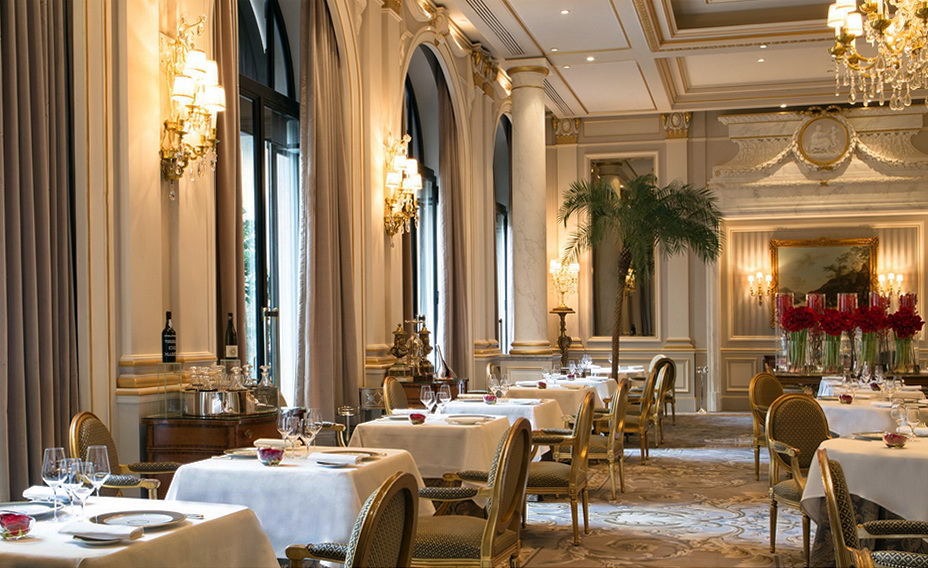They’re Common in Fancy Restaurants, usually on special occasions
‘The canapé we are instructed to eat first is a transparent ball on a spoon,’ Jay Rayner writes in a Guardian restaurant review. ’It looks like a Barbie-sized silicone breast implant, and is a “spherification”, a gel globe using a technique perfected by Ferran Adriàat El Bulli about 20 years ago. This one pops in our mouth to release stale air with a tinge of ginger. My companion winces. “It’s like eating a condom that’s been left lying about in a dusty greengrocer’s,” she says.’
The restaurant? Le Cinq, Paris. The bill? About $1000 for two.
 The scene of the crime: Le Cinq at George V Hotel. Photograph: Grégoire Gardette
The scene of the crime: Le Cinq at George V Hotel. Photograph: Grégoire Gardette
You’ve done it: booked a big name restaurant for a special occasion, a wedding anniversary or a special birthday or a night out with old friends from overseas. Your expectations are high, you’re in great spirits, you want this to be special and you’re willing to pay for the privilege.
You get there and find that your table is near the front door and catches the cold autumn draft every time someone enters or leaves. Your waiter hands out menus the size of phone books, and you’ve never heard of a single wine on the long list the sommelier hands you. Your first choice of wine raises a resigned eyebrow. You’re the host, and the others expect you to navigate these dangerous waters with competence. You’re terrified.
High Stakes Gambling
I remember the experience friends of mine had at Tetsuyas in the early days at Rozelle, when the venue was humble and the prices anything but, and the waiting list was weeks long. Not quite halfway through their dinner, an enormous row erupted in the kitchen: top of the voice shouting, meat cleavers flying and more. After that, dinner took a turn for the worse. No apology or discount was offered, and my friends later found out that the fracas was the great chef’s partner accusing him of having a bit on the side.
Other friends of mine decided to eat at the best restaurants in France and Spain, after they’d retired. 3 hats’, 3 Michelin stars, nothing but the best, trip of a lifetime for two couples. Every meal was around $1000 for 2, and that was a decade ago or more. The best outcome was that the restaurant met their expectations, the worst (and more common) was utter disappointment.
It’s not about the Food
I gave up fancy restaurants decades ago, when I worked out that they had a lot in common with bottles of Grange and expensive Swiss watches. People buy Grange to impress their friends, not because they intend to drink the wine. People buy fancy watches for the same reason, and not to tell the time. People go to fancy restaurants so they can drop names and boast of their experience.
OK, so they do produce interesting food to match the weird décor. It’s a fashion business though: years ago, the protein was served in the shape of small cylinders, then the meals were tiny morsels served on huge white plates decorated with splashes of colourful sauces, then foam was everywhere, and now the fashion is to blindfold the chef and get him to throw a handful of colourful bits and pieces on a wooden platter.
It’s not about Service either
Long ago, I learned how to cook decent food and buy good wine to go with it, but occasionally friends talk me into joining them for a meal at a fancy new restaurant. The last time an obsequious English waiter attended to our needs. He spoke to us in the third person: would Sir like sautéed nightingale fetlocks in dumpling gravy, or would he prefer braised briskets of corn-fed partridge?
My friend Jeffrey is a Francophile and Burgundophile, and has travelled widely in that great country. He sent me an email, saying he was not surprised by the Guardian lampooning the pomposity of the food that comes out of some of these “gold taps” Grand Hotel restaurants (anywhere in the world) and their overly pretentious service.
‘The food scene needs pricking like this to bring a sense of reality back, based on a perspective of common sense. We’ve bought ourselves experiences (staying) in many Grand Hotels (and dining in their restaurants) in Paris over the years. I just wanted to understand, see what all the fuss is about.
I can say, more than 50% of their restaurants need to be brought down a few ‘ego’ notches, back to creating food that is both impressive (in presentation and in flavours) and functional in satisfying appetites.
Often their wine lists are quite reasonably priced , in comparison to our local restaurant prices, and offering bottles that have been aged to perfection (rather than bottled just last month/ last year).’
I’ve Looked at Food from Both Sides Now
Service is something we simply do not understand in this country, says Jeffrey. ‘Even in our finest restaurants the wait staff greet you, run around you like a Labrador pup in excessive and intrusive friendliness. The French have decisive attentiveness, seamless and unnoticed table service down to a fine art … rarely intrusive and mostly discreet, reading their table guests’ attitudes with great skill. This is the way they cook too. Their hardest to please diners are the English-Oafs that whine and complain because they have fixed ideas and bog-boring food likes that are taken out of their ‘comfy’ zones by anything more sophisticated than their beloved, fat-oozing Fish & Chips. This Guardian critic sounds like one.
So, to read this critique in the Guardian filled me with knowing smirks, knowing both sides of this probable reality. Excessive, exaggerated and pompous grandeur from the hotel restaurant, and the propensity to revert into the whinging Pommy when faced with something they don’t like.’
Kim
